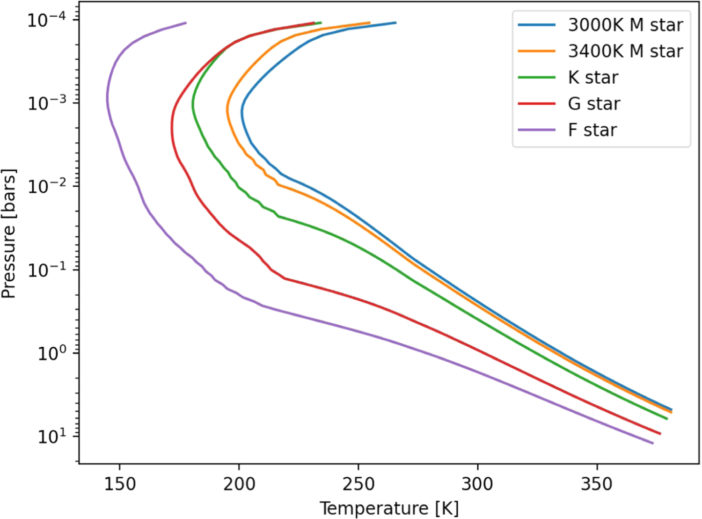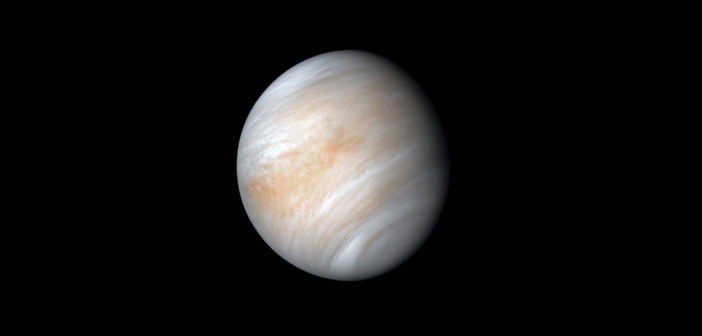Editor’s Note: Astrobites is a graduate-student-run organization that digests astrophysical literature for undergraduate students. As part of the partnership between the AAS and astrobites, we occasionally repost astrobites content here at AAS Nova. We hope you enjoy this post from astrobites; the original can be viewed at astrobites.org.
Title: The Outer Edge of the Venus Zone Around Main-sequence Stars
Authors: Monica R. Vidaurri et al.
First Author’s Institution: Howard University, NASA’s Goddard Space Flight Center, and Stanford University
Status: Published in PSJ
Planetary Habitability: Water, Water, Everywhere?
Classically, the benchmark for planetary habitability is liquid water: if a planet’s surface temperature is above freezing and below boiling, then it lies within its star’s habitable zone. Earth, obviously, is our best example of an inhabited, habitable planet in the habitable zone. Mars, now too cold for liquid water, is thought to have historically been much warmer, habitable, and possibly even inhabited! The evidence for this is strong enough that searching for past Martian life is a main science goal of the Perseverance rover. However, there’s another planet in our solar system on the other end of the habitability spectrum: Venus.
Venus
In April, as part of Earth Week ⨉ Astrobites, we heard from David Grinspoon about comparative planetology, which is a way of looking at the differences between the environments of Earth, Mars, and Venus. If Mars is the end state of a planet unable to sustain a greenhouse effect (not just a result of carbon emissions, and necessary to maintain liquid water), then Venus is the end state of a planet with a runaway greenhouse effect. Venus absorbed more radiation from the Sun than the planet could emit, which heated the planet to the point where all liquid water (if it had any) evaporated, and the water was then lost to space through photodissociation. Historically, the orbital radius at which a planet would be subject to this effect from its host star has defined the inner edge of the habitable zone. Any closer, and the planet would lose its water. However, this isn’t a hard limit, and the actual orbital radii at which Venus analogs can be found vary significantly with both stellar and planetary parameters. In today’s article, the authors run a grid of simulations to determine the exact location of the “Venus zone,” which overlaps with the classical habitable zone, for stars of varying masses and temperatures.
How to Build an Uninhabitable Planet
In order for a planet to undergo the runaway greenhouse effect, there must be sufficient greenhouse gases in its atmosphere. The specific amount is different for every planet, but for any particular planet, the amount primarily depends on how much radiation the planet receives from its host star. As the planet is irradiated by the star, different atmospheric species absorb and emit different amounts of starlight at different pressures/altitudes, heating and cooling the atmosphere. By increasing the amount of carbon dioxide relative to nitrogen and water (starting with present-day Earth values for CO2 and N2 and maintaining a certain humidity level), the authors can eventually induce a runaway greenhouse on the planet, producing a “Venus analog” planet. The authors then decrease the stellar flux, effectively moving the planet further away from its host star, until the runaway greenhouse can no longer be sustained. This yields the outer edge of the “Venus zone,” past which no increase in the amount of carbon dioxide will cause a runaway greenhouse effect.
This process is repeated for each stellar type in the grid: an F star (7200K), a Sun-like G star (5780K), a K star (4400K), and two M stars (3400K and 3000K). Habitable-zone planets around M stars are particularly tempting targets for further study as they have significant observational benefits, such as short orbital periods due to their close-in habitable zones and deep transits compared to planets around larger Sun-like stars.
Including a variety of stellar types in the model is important, not only because of their different brightnesses, but also because of their different spectra. As seen in Figure 1, larger and hotter stars are less efficient heaters of planetary atmospheres than smaller, cooler stars. An F star emits much more of its light as shorter-wavelength radiation compared to an M star, which emits much of its light in the infrared. The higher infrared flux from an M star is better absorbed by greenhouse gases in planetary atmospheres, which means that an M star will heat planets more than an F star.

Figure 1: Temperatures of planets receiving 1 Seff, the amount of radiation that Earth receives from the Sun. The planetary temperatures are inversely related to the temperatures of the host stars, since the planets’ atmospheres mostly absorb infrared radiation, while the spectra of hotter stars peak at shorter wavelengths. [Vidaurri et al. 2022]
Is Every Habitable Planet a Potential Venus?
Luckily, the authors found that while the Venus zone has significant overlap with the classical habitable zone, there are still places where habitable planets can exist with zero risk of runaway (see Figure 2). However, since there is so much overlap between the habitable zone and the Venus zone, future investigators must be careful to take the possibility of runaway greenhouses into consideration when studying potentially habitable planets. In addition, there is significant uncertainty in Venus’s atmospheric and geological history, though new in-situ measurements by the upcoming fleet of Venus missions (NASA’s DAVINCI+ and VERITAS, as well as the European Space Agency’s EnVision) will be able to uncover much of this unclear history. Just like the atmospheres of these simulated planets, the search for habitable planets is heating up. Work like this will hopefully ensure that the future Earth 2.0 isn’t actually a Venus 2.0!

Figure 2: The boundaries of the Venus zone (VZ) compared to the conservative habitable zone (HZ). The y-axis shows stellar temperature, which relates to how efficiently the stars can heat the planets’ atmospheres. The x-axis shows effective stellar flux, where 1 Seff is the amount of radiation Earth receives from the Sun. Between the green and blue dashed lines is the conservative habitable zone, while the gray area is the overlap region between the Venus zone and the habitable zone. [Vidaurri et al. 2022]
About the author, Yoni Brande:
I’m a third-year PhD candidate at the University of Kansas, working on exoplanet discovery and characterization. I primarily work with TESS transit data and Hubble Space Telescope exoplanet transmission spectroscopy data, and I’m also interested in enabling more collaborative science with open source astronomical software tools. When I’m not doing research or writing astrobites, I can be found in a sci-fi streaming binge, running, lifting, cooking, or on Twitter @YoniAstro.

